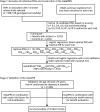Development and Validation of a Polygenic Risk Score for Stroke in the Chinese Population
- PMID: 34031205
- PMCID: PMC8424497
- DOI: 10.1212/WNL.0000000000012263
Development and Validation of a Polygenic Risk Score for Stroke in the Chinese Population
Abstract
Objective: To construct a polygenic risk score (PRS) for stroke and evaluate its utility in risk stratification and primary prevention for stroke.
Methods: Using a meta-analytic approach and large genome-wide association results for stroke and stroke-related traits in East Asians, we generated a combined PRS (metaPRS) by incorporating 534 genetic variants in a training set of 2,872 patients with stroke and 2,494 controls. We then validated its association with incident stroke using Cox regression models in large Chinese population-based prospective cohorts comprising 41,006 individuals.
Results: During a total of 367,750 person-years (mean follow-up 9.0 years), 1,227 participants developed stroke before age 80 years. Individuals with high polygenic risk had an about 2-fold higher risk of incident stroke compared with those with low polygenic risk (hazard ratio [HR] 1.99, 95% confidence interval [CI] 1.66-2.38), with the lifetime risk of stroke being 25.2% (95% CI 22.5%-27.7%) and 13.6% (95% CI 11.6%-15.5%), respectively. Individuals with both high polygenic risk and family history displayed lifetime risk as high as 41.1% (95% CI 31.4%-49.5%). Individuals with high polygenic risk achieved greater benefits in terms of absolute risk reductions from adherence to ideal fasting blood glucose and total cholesterol than those with low polygenic risk. Maintaining favorable cardiovascular health (CVH) profile could substantially mitigate the increased risk conferred by high polygenic risk to the level of low polygenic risk (from 34.6% to 13.2%).
Conclusions: Our metaPRS has great potential for risk stratification of stroke and identification of individuals who may benefit more from maintaining ideal CVH.
Classification of evidence: This study provides Class I evidence that metaPRS is predictive of stroke risk.
© 2021 American Academy of Neurology.
Figures





Similar articles
-
A polygenic risk score improves risk stratification of coronary artery disease: a large-scale prospective Chinese cohort study.Eur Heart J. 2022 May 7;43(18):1702-1711. doi: 10.1093/eurheartj/ehac093. Eur Heart J. 2022. PMID: 35195259 Free PMC article.
-
Polygenic risk scores for the prediction of common cancers in East Asians: A population-based prospective cohort study.Elife. 2023 Mar 27;12:e82608. doi: 10.7554/eLife.82608. Elife. 2023. PMID: 36971353 Free PMC article.
-
Genetic risk, incident gastric cancer, and healthy lifestyle: a meta-analysis of genome-wide association studies and prospective cohort study.Lancet Oncol. 2020 Oct;21(10):1378-1386. doi: 10.1016/S1470-2045(20)30460-5. Lancet Oncol. 2020. PMID: 33002439
-
Polygenic risk scores in atrial fibrillation: Associations and clinical utility in disease prediction.Heart Rhythm. 2024 Jun;21(6):913-918. doi: 10.1016/j.hrthm.2024.02.006. Epub 2024 Feb 7. Heart Rhythm. 2024. PMID: 38336192 Review.
-
Genome-wide association studies and polygenic risk scores for skin cancer: clinically useful yet?Br J Dermatol. 2019 Dec;181(6):1146-1155. doi: 10.1111/bjd.17917. Epub 2019 Jul 7. Br J Dermatol. 2019. PMID: 30908599 Free PMC article. Review.
Cited by
-
Statistical Methods for Disease Risk Prediction with Genotype Data.Methods Mol Biol. 2023;2629:331-347. doi: 10.1007/978-1-0716-2986-4_15. Methods Mol Biol. 2023. PMID: 36929084
-
Integrating polygenic and clinical risks to improve stroke risk stratification in prospective Chinese cohorts.Sci China Life Sci. 2023 Jul;66(7):1626-1635. doi: 10.1007/s11427-022-2280-3. Epub 2023 Mar 3. Sci China Life Sci. 2023. PMID: 36881318
-
Changes in Sleep Patterns, Genetic Susceptibility, and Incident Cardiovascular Disease in China.JAMA Netw Open. 2024 Apr 1;7(4):e247974. doi: 10.1001/jamanetworkopen.2024.7974. JAMA Netw Open. 2024. PMID: 38652473 Free PMC article.
-
Machine learning algorithms to predict stroke in China based on causal inference of time series analysis.BMC Neurol. 2025 May 31;25(1):236. doi: 10.1186/s12883-025-04261-x. BMC Neurol. 2025. PMID: 40450249 Free PMC article.
-
Cardiovascular risk assessment: The key path toward precision prevention.Chronic Dis Transl Med. 2023 Aug 1;9(4):273-276. doi: 10.1002/cdt3.90. eCollection 2023 Dec. Chronic Dis Transl Med. 2023. PMID: 37915392 Free PMC article. No abstract available.
References
-
- Montaner J, Ramiro L, Simats A, et al. . Multilevel omics for the discovery of biomarkers and therapeutic targets for stroke. Nat Rev Neurol. 2020;16(5):247-264. - PubMed
Publication types
MeSH terms
LinkOut - more resources
Full Text Sources
Other Literature Sources
Medical
Research Materials
